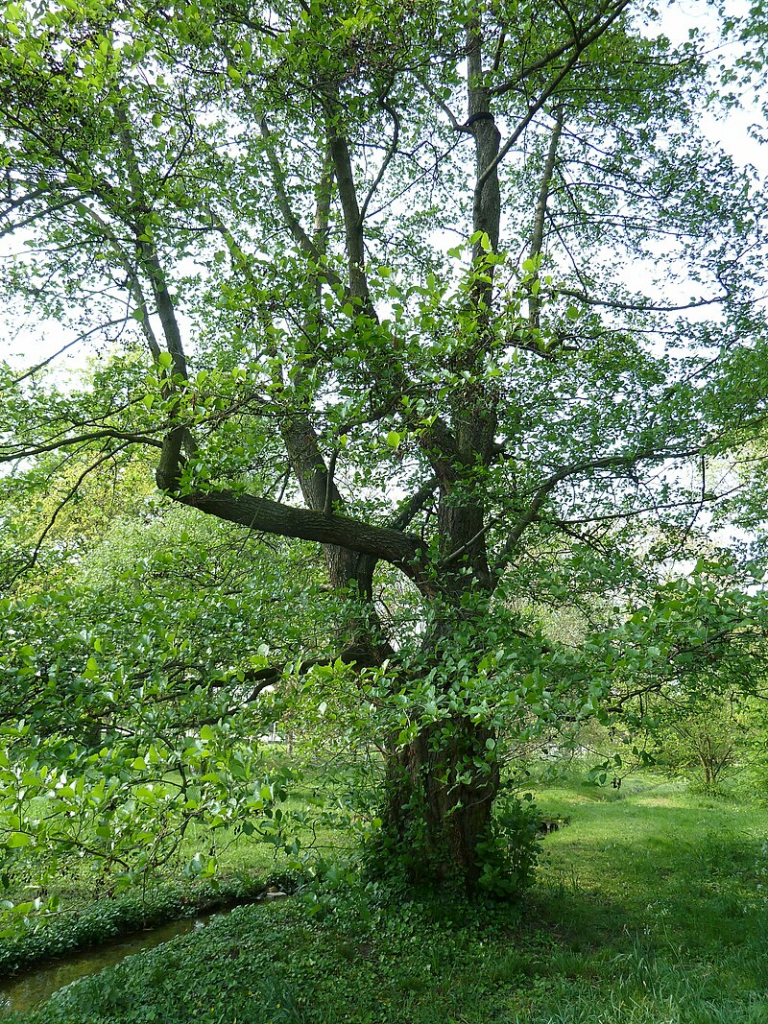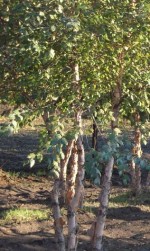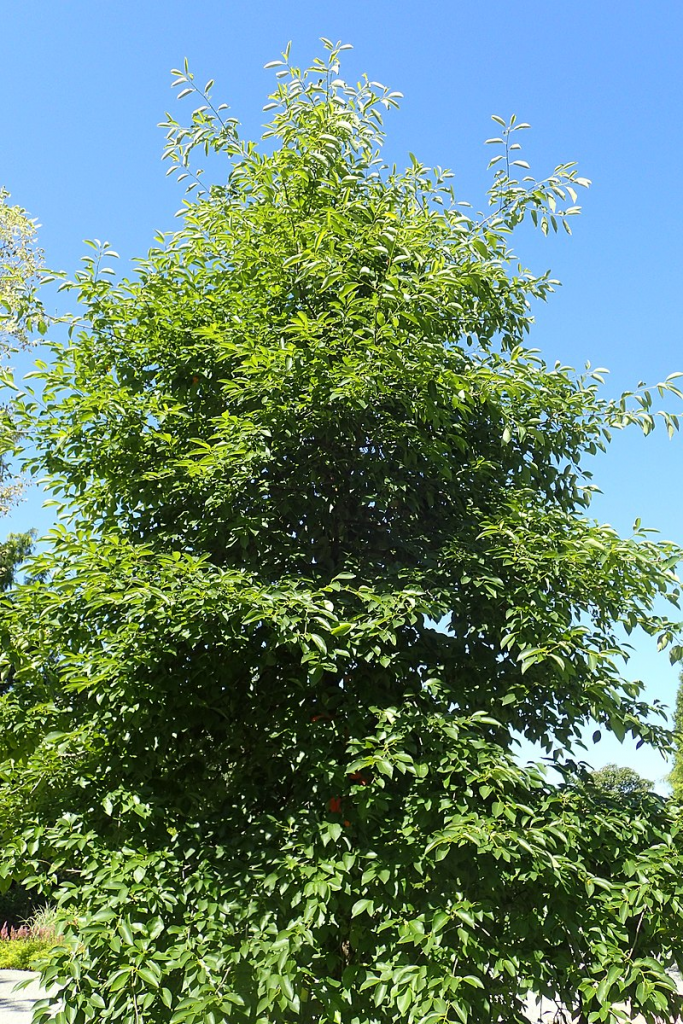
The following trees are suitable for the area of a rain garden that is the deepest and holds the most water for the most amount of time. They can tolerate standing in 6″ of water or less for about 24 hours. All but red maple and pin oak are also suitable for the middle area of a rain garden that holds several inches of water during and immediately after a rain fall but drains more quickly. Most of the trees tolerate some shade and many provide interest to the rain garden such as evergreen foliage, fall coloration, and interesting bark. Although all of the trees are suitable for the mid-Atlantic some are less hardy than others. This list is not meant to be comprehensive but intends to provide an interesting assortment of trees that may be used in a rain garden. Photo Credit: SEWilco, Wikimedia Commons
Red Maple (Acer rubrum)

Also known as scarlet maple, swamp maple, soft maple, Carolina red maple, Drummond red maple, and water maple, this deciduous tree is native to eastern and central North America. The tree can grow up to 120′ tall but is usually shorter, and has smooth light gray bark when young. It thickens, turns dark gray, and develops ridges and furrows with age. In early spring before the leaves emerge, drooping clusters of tiny red flowers appear. The flowers may be male or female and may be on the same or different trees depending on the growing conditions and variety. Pollinated female flowers produce V-shaped paired, winged fruits, called a samaras, that are 3/4″ long and are yellow, prik or red before turning turn tan or brown with maturity. The leaves are 2-6″ long and medium to dark green during the growing season turning red, orange, and yellow in fall. Photo Credit Wikipedia
Type: Deciduous tree
Height: 40-120′
Light: Full sun to partial shade
Hardiness: Zones 2-9
Smooth Alder (Alnus serrulata)

Also known as tag alder, brookside alder, and hazel alder, this deciduous shrub or small tree is native to eastern North America from Nova Scotia and southern New Brunswick south to northern Florida and eastern Texas where it grows in wet soils such as streambanks, riversides, and swamps. The plant grows 10-20′ tall and is multi-stemmed with a densely branched crown and a pyramidal form. It suckers and may form thickets. The alternate leaves are 2-5″ long and are medium to dark green above, pale green below. In late spring male and female catkins of flowers appear on the same tree. The showy male catkins are 2-4″ long, yellow in color, and occur in dropping clusters of 2-5 near the tips of the branches. The female catkins are 1/4″ long, red or purple, and occur in erect clusters of 2-5 at the tips of the twigs. They give way to cone-like structures about ½-¾” long, with dark brown woody scales that persist into winter. The cones contain nutlets that provide food for insect larvae, birds, and mammals. Photo Credit Aroche, Wikimedia Commons
Type: Deciduous shrub or small tree
Height: 10-20′
Light: Sun to part shade
Hardiness: Zones 4-9
Sweet Birch (Betula lenta)

Sweet birch is a deciduous tree also known as black birch, cherry birch, mahogany birch or spice birch, and is native to eastern North America from southern Maine and Ontario, south to northern Georgia and Mississippi, where it grows in dry woods, rocky slopes, and streambanks. Trees are usually single stemmed with smooth charcoal-gray bark marked by horizontal lenticels. The twigs emit the scent of peppermint when scraped. The ovate leaves are pleated, 2.5 to 6 inches long by 1 ½ -3.5 inches wide, shiny green above, paler below, and turn golden yellow in fall. Catkins of male and female flowers appear in the spring on the same tree. The fruit is a tiny winged nutlet. Photo Credit Wikipedia
Type: Deciduous tree
Height: 40-82’
Light: Full sun to part shade
Hardiness: Zones 4-7
River Birch (Betula nigra)

This deciduous tree is a native of low woods, stream sides, and riverbanks in the eastern part of the United States, from southern New England to northern Florida and west to Oklahoma and Kansas, It is usually multi-stemmed and grows relatively quickly to 40-60 feet tall. The leaves are 2-3.5″ long, shiny and medium green during the growing season, but turn pale yellow in the fall. The exfoliating bark may be cream or have a pinkish tinge at first but darkens to cinnamon brown as the tree matures. Photo Credit Wikipedia
Type: Deciduous tree
Height: 40-60’ H x 20-30’ wide
Light: Full sun
Hardiness: Zones 4-9
Sweet Gum (Liquidambar styraciflua)

Also known as redgum, American storax, hazel pine, bilsted, satin-walnut, star-leaved gum, and alligatorwood, this deciduous tree is native to eastern US and Mexico where it grows in a variety of habitats including wet river bottoms and moist woodlands. Growing from a shallow root system, the trees are up to 100′ tall, and have straight trunks with deeply ridged gray bark and sometimes corky wings on the twigs. The star-shaped leaves are 4-8″ across, have 5-7 deeply separated lobes, and are green during the growing season before turning a mixture of yellow, orange, red and purple in the fall. Inconspicuous, yellow-green, male and female flowers appear on the same tree in mid to late spring. Pollinated female flowers give way to pendulous, hard, spherical fruits (gum balls) that are bristly, about 1″ across and composed of 40-60 capsules containing 2 seeds. The fruits are green at first but turn brown with maturity, remain on the tree into winter and provide food for birds. The fruit creates unwanted litter. In addition, sweet gum can become invasive in favorable environments. Photo Credit Wikipedia
Type: Deciduous tree
Height: 60-100′
Light: Full sun to partial shade
Hardiness: Zones 5-9
Black gum (Nyssa sylvatica)

Also known as black tupelo, sour gum and pepperidge, this tall, straight, symmetrical deciduous tree is a native of northeastern United States from Maine to Florida and west to Texas. Large, glossy, leathery leaves are dark green in summer but turn yellow, red, and purple in fall. The flowers that appear in spring are inconspicuous but nectar-rich and are favored by honey bees. The bluish-black berry-like fruits that are produced in fall are an important source of food for many birds and other wildlife. Photo Credit Krzysztof Ziarnek, Wikimedia Commons
Type: Deciduous tree
Height: 30-60 ’ (to 100’ in the wild)
Light: Full sun to partial shade
Hardiness: Zones 4-9
Longleaf Pine (Pinus palustris)

Also called Southern pine and Georgia pine, this evergreen coniferous tree is native to the Atlantic and Gulf Coastal Plains in southeastern US from Virginia west to Texas and south to Florida. The seed germinates into a grass-like tuft that develops a deep tap root for 2-7 years before growing into a tree. The tree grows up to 125′ tall and has a straight trunk with a few short, stout branches forming an open, irregular crown. The reddish brown bark turns brown, thickens with maturity, and forms irregular, flaky plates. The dark green needles usually occur in bundles of 3, are 6-14″ long and very flexible, creating a weeping appearance. New growth clusters appear as silvery white “candles” that are 3-15″ long. Purple-blue male cones and dark purple female cones are produced on the same tree. Photo Credit Wikipedia
Type: Evergreen coniferous tree
Height: 60-125′
Light: Full sun
Hardiness: Zones 7-9
American Plane Tree (Platanus orientalis)

Native to riparian sites of southeastern Europe to western Asia, this long-lived deciduous tree is also known as Eastern sycamore, western plane, buttonwood, old world plane tree, and water beech. The deep rooted tree may grow up to 120′ but is usually less than 90′ tall and has a spreading crown, horizontal branching, and a single trunk with flaking, scaly, gray-brown bark. The palmate, maple-like leaves have 5-7 distinct lobes , and may provide red, amber and yellow color in the fall. Custers of male and female greenish flowers appear in spring on the same tree and pollinated female flowers give way to 1 3/8″ wide balls of small, one-seeded fruits that ripen in the fall and persist into winter. Photo Credit Wikipedia
Type: Deciduous tree
Height: 60-90′ H
Hardiness: Zones 7-9
Swamp White Oak (Quercus bicolor)

Growing up to 90’ tall, this deciduous tree is native to moist areas in bottomlands and lowland such as riparian soils and the edges of swamps from Massachusetts to Wisconsin, south to Virginia and Missouri. The trees have brown to grey to brown bark depending on maturity. The bark becomes scaly and furrowed and may begin to peel with age. The lobed glossy green leaves are 3-9″ long, hairy, with light green or white undersides. In the fall they turn brown to yellow or red. In spring, elongated pendant cluster of inconspicuous yellow-green male flowers and green to red female flowers appear on the same tree. The fertilized female flowers give way to shiny brown acorns that are 1/2 to 3/4″ long with a cap that encloses 1/3-1/2 the acorn.
Type: Deciduous tree
Height: 50-90′ H
Light: Full sun
Hardiness: Zones 3-8
Pin Oak (Quercus palustris)

Pin oak, also known as swamp Spanish oak, is a deciduous tree native of Eastern and Central US where it grows in areas with moist acid soils such as floodplains, river bottoms, and along streams. The trees have in a pyramidal form with the highest branches upright, the mid-level branches horizontal, and the lower branches drooping downward. The trunk is straight and has smooth, light to dark grayish brown bark with shallow, scaly ridges. The simple alternate leaves are four to six inches long by two to four inches wide and are deeply cut into five or seven bristle tipped lobes. They are glossy dark green in the summer turning to red in the fall. Insignificant greenish yellow male and female flowers appear in catkins on the same tree in spring as the leaves emerge. In the fall, acorns ½ inch long appear and have shaped cups that enclose one third of the nut appear. Photo Credit Wikipedia
Type: Deciduous tree
Height: 50-80’
Light: Full sun
Hardiness: Zones 4-8
Black Willow (Salix nigra)

Black willow is a deciduous single to multiple-stemmed tree native to North America from New Brunswick to Minnesota, south to Florida and Texas where it grows in low woods, floodplains, pond margins, and ditches. Young twigs are green and flexible while the dark brown to black bark on the branches and trunk develops fissure and may become shaggy with age. The linear pointed leaves are two to six inches long, dark green with silvery undersides during the growing season but turn an uninteresting greenish-yellow in fall. Inconspicuous yellowish green male and female flowers are produced in separate catkins one to three inches long on different trees in spring as the new leaves emerge. The fruit is small capsule less than ¼ inch long filled with numerous minute seeds. Photo Credit Wikipedia
Type: Deciduous tree
Height: 30-60’
Light: Full sun to part shade
Hardiness: Zones 4-9
Bald Cypress (Taxodium distichum)

This iconic tree of southern swamps, is found from Delaware to Texas and Missouri, and is the state tree of Louisiana. It is alternatively called swamp cypress for its habitat, but is called bald cypress because it looses its leaves in winter. When growing in water it produces aerial roots known as pneumatophores which provide oxygen to the roots and allow the tree to survive. The bark is dull reddish brown with vertical fissures and the linear leaves are soft, flattened and arise alternately along the shoot. The male and female strobili are produced on the same tree but are different in size and shape. Photo Credit Daniel Di Palma, Wikipedia
Type: Deciduous tree
Height: 50-130’
Light: Full sun
Hardiness: Zones 4-9
Eastern Hemlock (Tsuga canadensis)

Also known as Canadian hemlock, this coniferous tree is native to eastern North America. It grows 40-70′ tall and has a conical form and drooping branches. The short dark green needles are arranged spirally in flat sprays on the main branches and have two white bands on their undersides. Male and female cones appear in the fall on the same tree but differ in appearance.
Type: Evergreen coniferous tree
Height : 40-70′
Light: Full sun to partial shade; tolerant of full shade
Hardiness: Zones 3-7